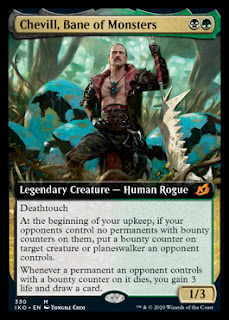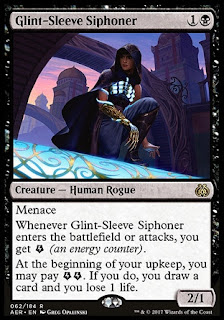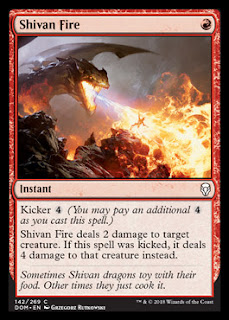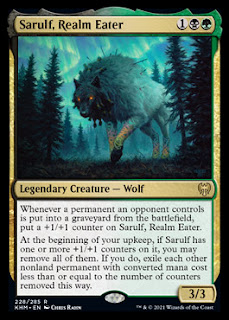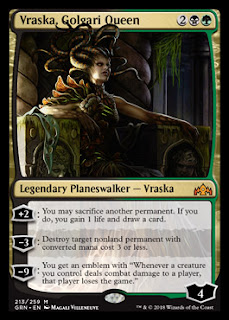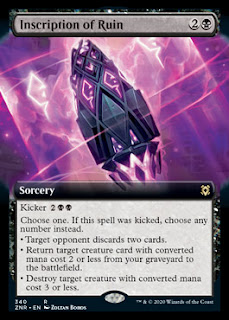Let's dive in.
Chevill is beyond bonkers. I think it's a testament to how absurd the power level of printings have been in the last two years that Chevill isn't a staple of at least Pioneer, nevermind Historic and Standard. A card like this in the past that was a card advantage engine stapled onto a mana-cost worthy body would normally lose you life. Think Dark Confidant, Glint-Sleeve Siphoner, or Midnight Reaper. Instead, Chevill draws you cards and plays defense. That is the recipe that we want in our best cards, the ability to be proactive and protect you at the same time. Some of the best creatures in Magic's history fit this description: Tarmogoyf, Stoneforge Mystic, Scavenging Ooze, Thing in the Ice, Kitchen Finks, Courser of Kruphix.
Chevill doesn't really force you to to do anything special to accomodate him, but he certainly makes your removal spells better. We aren't playing Bloodchief's Thirst and Maelstrom Pulse and Chandra because of Chevill, we play them to kill our opponent's stuff, but Chevill turns your necessities into an advantage. He's perfect for this kind of deck.
Chevill also neatly dodges the legend rule. Opponents are often willing to trade a creature in combat just to get him off the table, which frees up the second copy in your hand. If your worst case scenario is just Doom Blade, then I like where we're at. Also, at first glance, Chevill looks like a liability against control decks, but in practice it's a huge plus to be able to recoup some of the inherent card disadvantage that comes with casting removal spells on planeswalkers. I play three Chevill normally, but in aggro-heavy metagames, don't be afraid to go to four if you anticipate needing to trade him off early.
Ooze is quite a bit different than Chevill, but accomplishes a lot of the same thing. It adds value to your removal spells, since you can eat their creatures for life and counters. Ooze also can act as your late game nail in the coffin card against aggro strategies, since with more mana at your disposal it turns into Pelakka Wurm pretty quickly.
Ooze also does this thing that's really special in Magic: it's a main-deckable hate card. Lots of decks have Uro or Cauldron Familiar, sure, and Ooze has some incidental value there, but Ooze makes your deck better by being a pretty dedicated hate card against graveyard decks while being in your starting 60. It's probably not as good as Leyline of the Void (although even that's up for debate, I've never attacked for nine with a Leyline of the Void), but it also doesn't take up space in your sideboard. It's also there for game one, so you have more chances to steal games by drawing your hate cards.
Ooze's only drawback in my mind is that I find myself boarding it out against decks without creatures. But again, Ooze's floor is really high, a grizzly bear that can pump itself every once in a while off your own dead creatures or can help keep Search for Azcanta or Torrential Gearhulk in check. I like playing four, and would not go below four as long as Uro is in the format.
Channeler is first up in a pretty long list of cheap creatures that I've been trying out (well, Knight of the Ebon Legion is kind of in this category, too). It has a lot of the things we look for in a threat for this deck: it's good early, it's good late, and it can help stop your opponent's game plan. It even has the ability to smooth out your draws if you're mana screwed or get rid of excess lands to find removal.
Channeler lives in this weird space where it's kind of a build-around card, but also the payoff is that you just get a 4/4 creature when you finally get there. Increasing your instant and sorcery count helps, but isn't super necessary, this deck doesn't care that much about getting the 4/4 turned on quickly, so long as it happens. But, Channeler does necessitate that we play more cards that are versatile and going to be useful as one of the two cards we hit off its ability. Kazandu Mammoth comes to mind as a card that's great here, but so is Maelstrom Pulse. The problem with this, though, is that if we're playing a bunch of versatile, slower cards to facilitate Channeler, then we have less desire to dig through our deck because the cards in our hand get the job done fine.
However, you can't say that Channeler is not good. I have had a lot of games where a Channeler came down early, perhaps did some blocking or chip damage, helped hit a critical removal spell or land drop, then turned the corner and hit for four a turn until they were dead. Not a lot of cards can compete with the likes of Chevill and Scavenging Ooze at checking all the boxes of proactive, defensive, and cheap, but Channeler does a great job.
To put this into perspective, I want this deck to have 10 to 13 cheap creatures, cheap being one or two mana. Channeler, in my mind, is at the top of the list behind Scavenging Ooze and Chevill. That said, if you're planning on playing this deck or a similar list, test for yourself and see what you like. I'll run through the rest of the contenders here and talk about their pros and cons, but really it might all come down to the metagame you predict and the way you like to play the deck.
Gifted Aetherborn is definitely a what-you-see-is-what-you-get kind of card. That said, whether it belongs in the deck is longer discussion. A few months ago, Historic was a much more aggressive format, with Gruul being the de facto top deck in the format and things like mono-red and others not far behind. In that moment, Aetherborn was excellent. The ability to gain a few incidental life points, trade with big creatures, and be a cheap and somewhat resilient threat goes a long way against the blunt-object decks of the format.
The format has shifted, however, and that's a big part of why Aetherborn isn't in the deck anymore. Even the current most popular aggro deck, Goblins, has a much easier time dealing with Aetherborn than Gruul, since it can just cast Muxus and attack for 40 or whatever. But the other part of the equation is that Aetherborn's mana cost is more prohibitive if we want to include things like Shatterskull Smashing and Kazandu Mammoth.
Merfolk Branchwalker was a mainstay of the deck for a long time, but some stronger stuff got printed and I haven't been back for a while. Still, this card does a lot of the things we want, and isn't as bad a late game card as you might expect, since there's a good enough chance that it draws you a free card. Nowadays, there's a good chance that free card will actually be a spell, like Kazandu Mammoth or Shatterskull Smashing. (Edit: This is wrong. Kazandu Mammoth et al don't count as lands for the Explore trigger.)
One thing that Merfolk Branchwalker does well is that it can often have good stats right out of the gate. It's not our plan, per se, to cast two mana 3/2s on turn two. If it was, I'd play Voltaic Brawler. However, a Branchwalker that doesn't flip over a land can put a lot more pressure on a control opponent than most other two drops, and that's the card at its worst. In order to get the most out of Branchwalker, you need any option that it gives you to be good, and I think our deck does that well. We're into drawing an extra card, and we're into attacking. We are into trading with a big creature and we're into drawing an extra card and trading with a small creature. All good stuff, but less raw power than most of the other two drops available.
Siphoner might be the best proactive card available for us, but it's also the worst defensive card. Not only do you lose life when you draw the card, but you have to attack in order to get it, and Siphoner doesn't block especially well.
You could say that the way to maximize Siphoner is to play with energy producers, which is true, but the other way to maximize Siphoner is to play with lots of cheap removal. I think the best shell of Siphoner adds in extra Fatal Push and possibly Harnessed Lightning, not only for its energy production but for being a good, cheap removal spell. That's because Siphoner is going to give you a raw volume of cards, so you can afford to have one of them be a dud in a matchup where removal isn't at a premium. Additionally, in order to have Siphoner work against creature decks, you need those creatures to be off the battlefield.
Siphoner runs into the same problem that Thoughtseize has, which is that while it's strong most of the time, there will be matchups where it's extremely bad and needs to be boarded out. With Thoughtseize in the deck, this means you're going to want to have eight cards to bring in against a dedicated burn deck, if you're playing four Siphoners.
To sum up this section, my rankings for best cheap threats are:
1. Scavenging Ooze
Also number 1. Chevill
3. Magmatic Channeler
4. Knight of the Ebon Legion
5. Glint-Sleeve Siphoner
6. Merfolk Branchwalker
7. Gifted Aetherborn
Take rankings like these with a grain of salt. Each of these cards is going to be better based on the build of your deck, the way that you play the deck, and the opponents you expect to face. I think they all have their merits and I wouldn't consider you wrong for playing any of them.
Kroxa, however, is a card that I don't like very much in this deck. I've touched on this before, but in order to maximize Kroxa, we need to really re-work a lot about the strategy of the deck, or have a very specific metagame that we expect to face.
Kroxa opens us up to graveyard hate that I don't want to get involved with. Uro is the number one card in the format right now, so people are prepared for this effect. If we're going to run the risk of being nailed by opposing Scavenging Oozes and Klothys, then we should make sure that we're getting the most out of Kroxa as we can. Run down this logic line long enough and you end up just building Rakdos Arcanist.
Additionally, Kroxa is slow. It doesn't effect the board at all, it gets rid of your opponent's worst card, if they even have any, and it's honestly kind of hard to cast from your hand, let alone when you escape it. Add to that how bad it is with Kazandu Mammoth in the deck, and I'm just kind of over it. It's splashy and wins big when it wins you the game, but I haven't missed it since I stopped playing it.
~
That's it for two-drop creatures for Jund Midrange in Historic. There are plenty more that I think are pretty good cards, but don't quite cut the mustard for slots in this deck. Let me know in the comments if there's any that you think I may have missed or to voice your opinion. Thanks for reading!
